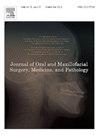A case of adenocarcinoma, not otherwise specified of the upper lip requiring differentiation from lip metastasis of lung adenocarcinoma
Abstract
Adenocarcinoma, not otherwise specified (NOS) exhibits ductal differentiation without the diagnostic histomorphological features of other defined salivary carcinomas. Adenocarcinoma, NOS rarely occurs in the lip, and when adenocarcinomas occurs in more than one organ, it is often difficult to identify the primary site. We report a case of adenocarcinoma of the left-upper lip occurring in a 67-year-old woman, which need to clearly identify the type of tumor required collaboration with Department of Respiratory Surgery to identify the primary origin site. The woman was referred to our department because of a painless mass in the upper lip. The clinical diagnosis was a benign tumor or mucous cyst and we performed a biopsy. The histopathological diagnosis was adenocarcinoma, NOS. Chest computed tomography demonstrated a mass in the lower-right-lung lobe. We suspected lung metastases and histopathologically attempted to identify the primary lesion. Immunohistochemical analysis showed positive staining for cytokeratin 7 and negative staining for thyroid transcription factor 1 and napsin A. The analysis identified the primary lesion as a salivary adenocarcinoma, NOS. We performed a full-thickness resection of the left-upper lip and reconstructive surgery of the upper lip. Postoperative computed tomography at the 3-month follow-up showed no mass in the lower-right-lung lobe. Follow-up examinations have shown no evidence of recurrence for 4 years after the surgery.

 求助内容:
求助内容: 应助结果提醒方式:
应助结果提醒方式:


